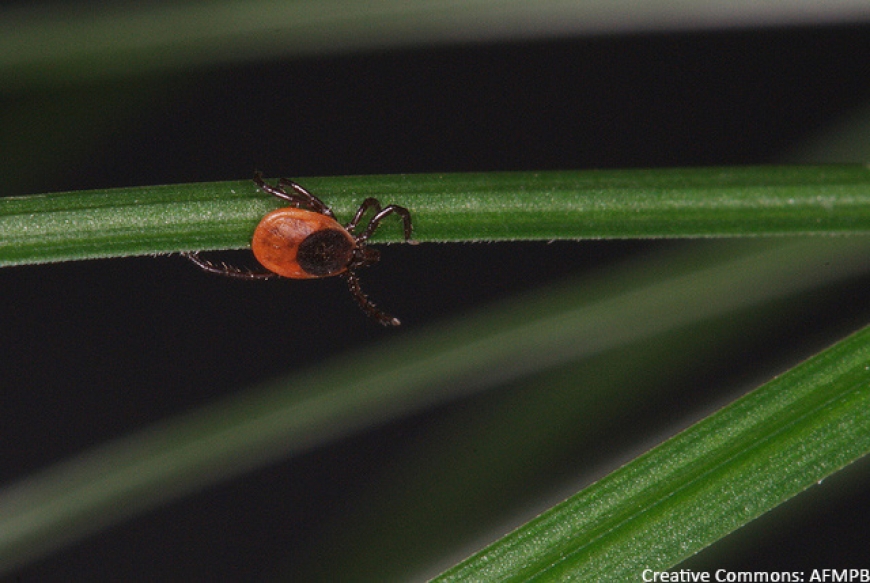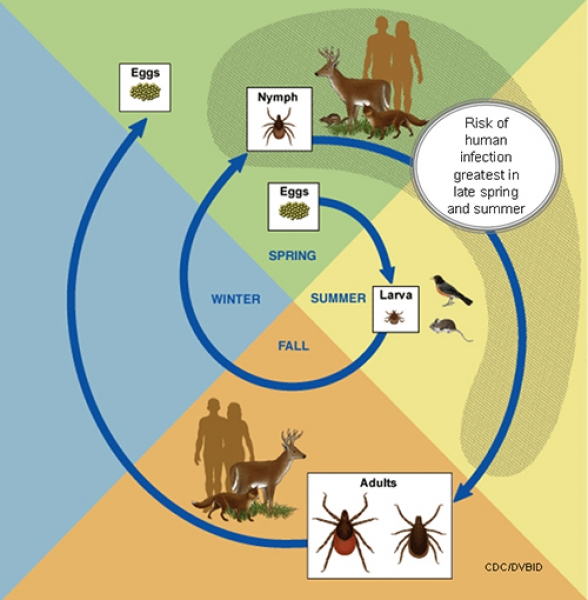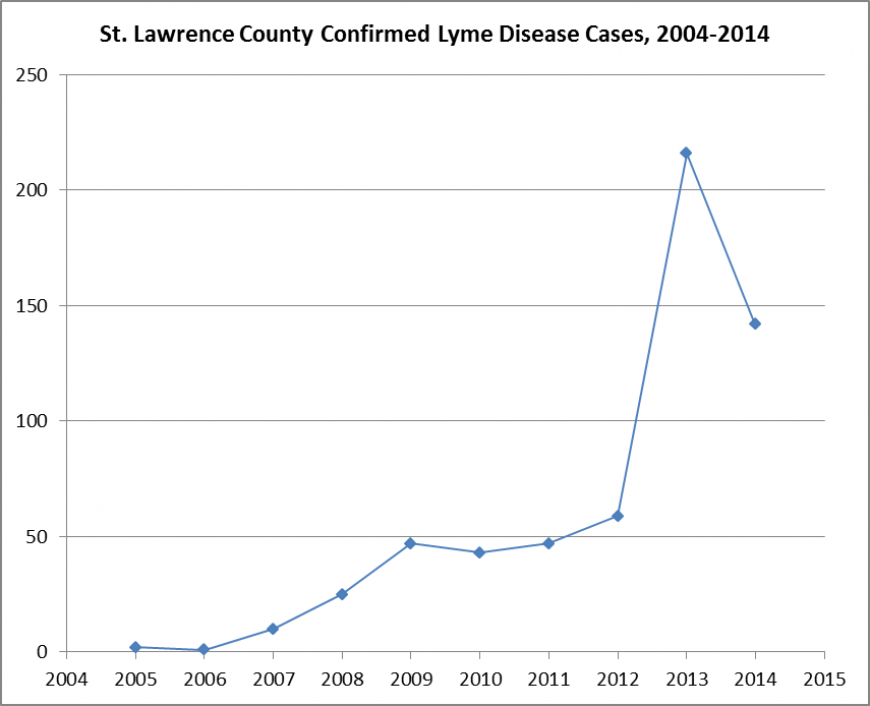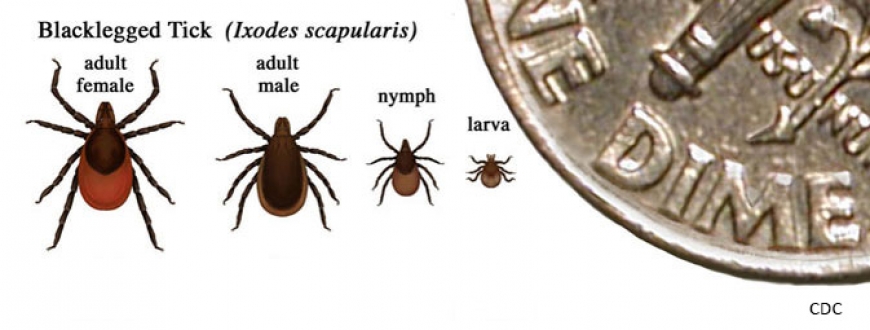







Lyme Disease Ecology Part One: A Ticky Situation
All year round we await the North Country summer – when the landscape is green and lush, the days are long, and shorts finally seem like a viable clothing option. In early summer we can easily tolerate a few mosquitos and black flies in exchange for the abundance of outdoor opportunities that our region offers. But over the last decade, Lyme disease has emerged as a serious concern for northern New York residents seeking to enjoy the summer months outdside.
Lyme disease is a bacterial infection transmitted to humans by the blacklegged tick (Ixodes scapularis), also commonly called the “deer tick.” Symptoms include headache, fever, joint and muscle aches, fatigue, swollen lymph nodes, and skin rashes (sometimes, but not always, bulls-eye shaped) in the area of the tick bite. If detected early, the Lyme disease bacteria (Borellia bergdorferi) can be treated with a short course of antibiotics. If left untreated, it can cause severe symptoms including heart problems, memory loss, and neurological issues. Beyond human suffering, this small pathogen imposes a tremendous economic cost: it is estimated that treatment for Lyme disease costs between 712 million to 1.3 billion dollars per year in the US.
Lyme disease was first recognized in Lyme, Connecticut in 1975. The eastern seaboard from Maine to Virginia, and areas of Minnesota and Wisconsin, are considered Lyme disease endemic – that is, Lyme infected ticks have been present in these areas at least since the disease was named, and likely even earlier than that. Southeastern New York has long been a hot spot: according to the CDC, five counties in the Hudson Valley (Columbia, Dutchess, Greene, Putnam, and Ulster) ranked in the top ten in the nation for per-capita Lyme disease rates from 2002-2006.

In the North Country, Lyme disease is a much more recent phenomenon: the first recorded case occurred in 2002. According to the St. Lawrence County Health Department, 147 cases were reported in 2014, a 330% increase since 2010. In neighboring Jefferson County, cases increased by 556% between 2002-2006 and 2007-2011 (the CDC reports data in five-year intervals)*. Small mammals harboring the Lyme disease bacteria have been found in Paul Smith’s at elevations as high as 1,650 feet, where researchers previously thought blacklegged ticks were not present. On top of that, it seems everyone knows someone (or is someone) who has come down with Lyme disease in the past few years. If conversations with friends and in online comment sections are any indication, ticks are becoming an increasingly common sight, and a real cause for concern among North Country residents.
What accounts for the uptick (ahem) in Lyme disease cases across the North Country in the past decade? Understanding why Lyme is on the rise requires a nuanced examination of our local ecology, our climate, our healthcare system, and the ways humans interact with the environment (in other words, a question much too big for a single blog post). This is the first in a series of posts that will examine what we know - and don't know - about the ecology of Lyme disease, and what it means for outdoor enthusiasts in the North Country.
Here we will look at the life cycle of the blacklegged tick, and why it is so effective at transmitting pathogens to humans. In our next installment, we'll examine the role of biodiversity in determining human risk for Lyme disease. In our third installment we will hear from local researchers who are studying the emergence of Lyme disease in the Adirondacks and Champlain Valley. Finally, we’ll cover how we can protect ourselves from ticks and the diseases they carry, so that we can continue to enjoy the outdoors safely.
“Questing” for Blood: The Blacklegged Tick
First, a note about naming: While many tick species exist, the blacklegged tick (Ixodes scapularis) and its west coast cousin, the western blacklegged tick (Ixodes pacificus), are the only known vectors for the Lyme disease bacteria in North America. Both are also commonly called the “deer tick,” but the preferred nomenclature of Lyme disease researchers is blacklegged tick – “deer tick” reinforces the false notion that the ticks that spread Lyme disease feed primarily on deer. While it is true that Ixodes scapularis will select deer as a host, they are in fact perfectly happy feeding on a wide range of vertebrates –birds, reptiles, amphibians and mammals (including humans, of course). In Part Two we’ll talk about why this is significant.

While it is easy to write blacklegged ticks off as repulsive pests, it could also be argued that they are fascinating creatures, exquisitely equipped to survive a wide range of hosts, habitats, and environmental conditions. Contrary to popular belief, ticks cannot jump or fly, and they will not intentionally drop onto you from above. They move slowly, but are highly sensitive to carbon dioxide, temperature, and infrared light, allowing them to detect a warm-bodied vertebrate passing by. Ticks seek hosts through a behavior called “questing,” in which they climb to a nearby high point – a leaf on the forest floor, a blade of grass, a knee-high understory plant – and stick their front legs in the air, ready to catch a ride on their next meal. When an animal passes by, ticks latch on with the barbed hooks on their front legs, and then crawl around (usually upward) until they’ve found a suitable spot to bite. On humans, common places for tick bites are behind the knee, in the groin area, the armpits, and around the sock, belt, or hairline.
A tick’s mouth parts are a horrifying evolutionary marvel - they contain two tiny saw-like blades that help them cut through the host’s skin, and a feeding tube structure called the hypostome, through which the tick sucks up blood. The hypostome has reverse barbs (like a fishhook) which keep it in place and make the tick difficult to remove. As a tick begins to feed, it also secretes saliva with anesthetic properties, which makes its bite nearly painless, so you're less likely to detect it. Once attached, it will feed for 3-5 days until it becomes engorged. During this time, it exchanges saliva and other fluids with the blood of the host – if a tick (or a host) is carrying a pathogen, this is when it is transferred. Once a tick is satiated, it will drop off the host and begin to digest its meal.
Now that we’re all thoroughly grossed out, let’s move on to the blacklegged tick life cycle. Blacklegged ticks live for two years and have three distinct life stages: larva, nymph, and adult. Larval ticks, each about the size of the period at the end of this sentence, hatch from eggs in broods of approximately 2,000 in mid-summer. Because they are so small, larval ticks typically quest from the forest floor, where their first meal usually comes from a passing rodent such as a mouse, shrew, or chipmunk. Importantly, larval ticks are born disease free – they do not inherit the pathogens their parents may have carried. In order for ticks to become a vector for Lyme disease (or any other disease that can be transmitted from ticks to humans), they must become infected by feeding on an animal that already harbors the pathogen.

After digesting their first blood meal in summer, larval ticks lay dormant on the forest floor through fall and winter, until they emerge the following spring as nymphs. Nympal blacklegged ticks, which are approximately the size of a poppy seed, will be active from approximately April-July, seeking a host for their second meal. It is believed that most human cases of Lyme disease are the result of a nymphal tick bite - they’re just small enough to avoid our detection. Once they’ve fed, nymphs will molt as adult ticks in the fall. A common final host for adult blacklegged ticks is white-tailed deer. Often, deer are also the site where adult ticks meet to mate. Science journalist David Quammen once wrote that for blacklegged ticks, “a whitetail in the woods of Connecticut, during November, is alike a teeming singles’ bar in lower Manhattan on Friday night, crowded with lubricious seekers.” That sounds like a rom-com I’d rather not watch.
Female adult ticks that have mated in fall will spend winter in the leaf litter, and die in spring after laying their eggs. Those eggs hatch in mid-summer, allowing the cycle to begin again.
What matters most to you, as the unlucky recipient of a tick bite, is where the tick that bit you had its last meal. As was established earlier, a tick isn’t born harboring dangerous pathogens – it must contract Lyme disease from a host during one of the three meals it enjoys in its lifetime. And it turns out that certain hosts may be disproportionately more likely to harbor the Lyme disease bacteria compared to others. More on that in the next installment.
*Because Lyme disease can be difficult to diagnose with certainty, and the Centers for Disease Control only count confirmed Lyme disease cases, many probable cases of Lyme disease are either undiagnosed or unreported. Official counts likely represent only a fraction of the actual number of cases.


I look forward to the next installments!